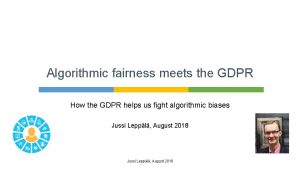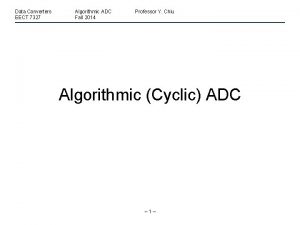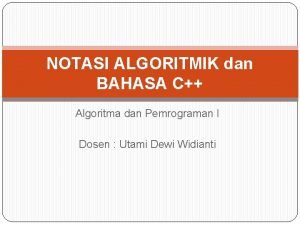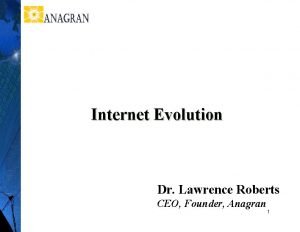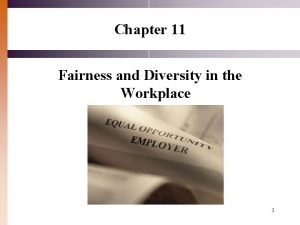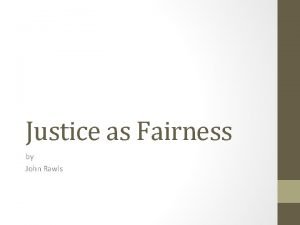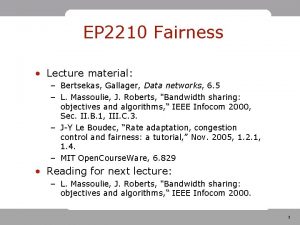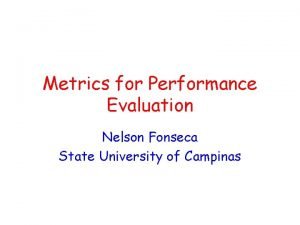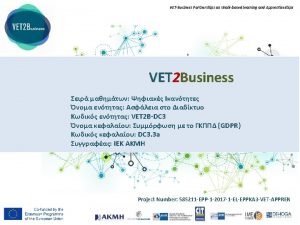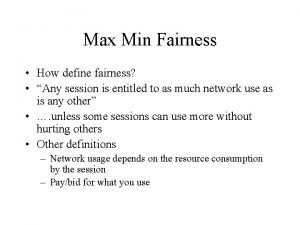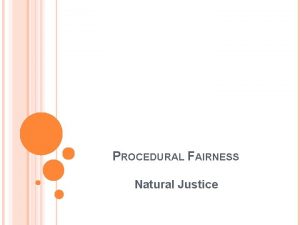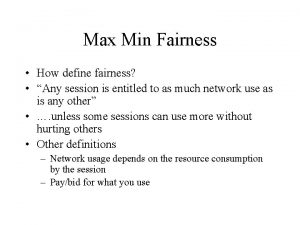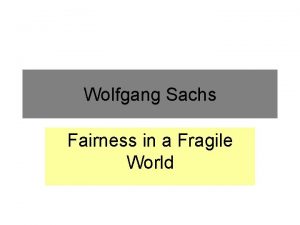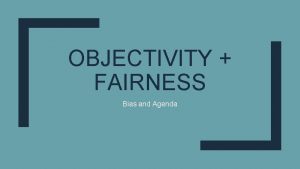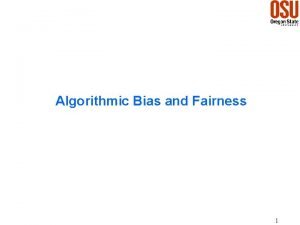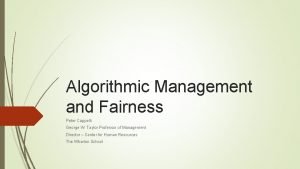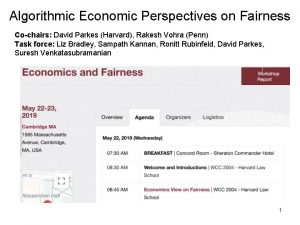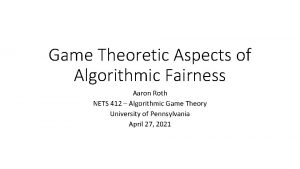Algorithmic fairness meets the GDPR How the GDPR










![Other examples[9] § Recruitment § Getting to the university § Credit scores § Online Other examples[9] § Recruitment § Getting to the university § Credit scores § Online](https://slidetodoc.com/presentation_image/2e631131e9cdbd94f173611248c885e2/image-11.jpg)







![References 1/2 [1] Council Directive 2000/43/EC of 29 June 2000 implementing the principle of References 1/2 [1] Council Directive 2000/43/EC of 29 June 2000 implementing the principle of](https://slidetodoc.com/presentation_image/2e631131e9cdbd94f173611248c885e2/image-19.jpg)
![References 2/2 [7] Virginia Eubanks (2017): Automating Inequality, How High-tech Tools Profile, Police, and References 2/2 [7] Virginia Eubanks (2017): Automating Inequality, How High-tech Tools Profile, Police, and](https://slidetodoc.com/presentation_image/2e631131e9cdbd94f173611248c885e2/image-20.jpg)

- Slides: 21

Algorithmic fairness meets the GDPR How the GDPR helps us fight algorithmic biases Jussi Leppälä, August 2018 1

Content § Fairness in the GDPR § Group fairness § Algorithmic discrimination and fairness paradox § Conclusions Jussi Leppälä, August 2018 2

Definitions of fairness § Algorithmic fairness often refers to non-discrimination of individuals § Directive 2000/43/EC[1], Race Equality Directive: § “direct discrimination shall be taken to occur where one person is treated less favourably than another is, has been or would be treated in a comparable situation on grounds of racial or ethnic origin; ” § “indirect discrimination shall be taken to occur where an apparently neutral provision, criterion or practice would put persons of a racial or ethnic origin at a particular disadvantage compared with other persons, unless that provision, criterion or practice is objectively justified by a legitimate aim and the means of achieving that aim are appropriate and necessary. ” § Other laws define other attributes § Fairness can also have wider interpretations: § GDPR appears to use a broad definition but recital 71 also talks about nondiscrimination. Jussi Leppälä, August 2018 3

What is algorithmic discrimination? § General definitions can be applied. Avoiding § direct discrimination can be straightforward. § indirect discrimination can be challenging: big datasets and proxy attributes. § Proposed criteria for non-discrimination: § Statistical parity § Outcome test § Equal false positive and false negative rate Jussi Leppälä, August 2018 4

Search engine bias § Encyclopedias, library catalogues, and editorial oversight § Search engines may emphasize popularity more than quality. § Race bias and gender bias[2] => § Search engines not exposed to the same criteria as more traditional publishing § Bias against a group, not an individual Jussi Leppälä, August 2018 5

Fairness in the GDPR § GDPR is all about the rights of an individual, it may not be effective for fighting all algorithmic fairness. § Fairness is listed as one of the mandatory data processing principles under Article 5 of the GDPR. There is no definition but it can be illustrated by three points[3]: Effects considered Expected, explained Jussi Leppälä, August 2018 No deception 6

Algorithmic Grading of Student Essays § Several US states already use automated grading of essays on standardized tests[4]. § Cost savings, speed, and impartiality. § Utah lets machines be the sole judge of the vast majority of essays. In about 20 % of cases, human oversight is flagged. § Limitations § Les Perelman designed a program called the Babel Generator which creates essays that make no sense, but earn top scores from robo-graders. § Human interaction supports learning. § Algorithmic grading can help expose human biases. *Basic Automatic B. S. Essay Language Jussi Leppälä, August 2018 7

Automated decision making and the GDPR The GDPR Article 22 • “…the right not to be subject to a decision based solely on automated processing, including profiling, which produces legal effects concerning him or her or similarly significantly affects him or her” Exceptions • “Necessary for a contract • Is authorized by Union or Member State law • Is based on explicit consent” Safeguards • “…the right to obtain human intervention on the part of the controller, to express his or her point of view and to contest the decision. ” Jussi Leppälä, August 2018 8

Informing obligations under the GDPR All processing • Strong informing: purposes of processing etc. Article 22 processing • …meaningful information about the logic involved, as well as the significance and the envisaged consequences of such processing for the data subject Questions • “right to explanation” vs. “meaningful information”[6], system functionality vs. individual decision. • Trade secrets and fraud detection • explainable in human terms (deep learning)? Jussi Leppälä, August 2018 9

Insurance and sharing risks § If we have a vast amount of data about everyone, how is risk sharing going to work, e. g. genetic testing and private health insurance? § The decisions may be based on well-grounded science, but they can create an unacceptable situation from an individual’s point of view. § Sometimes we may not want to use all data we have. It would not be “fair” => who determines the limits? Jussi Leppälä, August 2018 10
![Other examples9 Recruitment Getting to the university Credit scores Online Other examples[9] § Recruitment § Getting to the university § Credit scores § Online](https://slidetodoc.com/presentation_image/2e631131e9cdbd94f173611248c885e2/image-11.jpg)
Other examples[9] § Recruitment § Getting to the university § Credit scores § Online advertising: targeting the vulnerable § Problems: data quality, transparency, inappropriate sharing Jussi Leppälä, August 2018 12

Law enforcement - recidivism risk § COMPAS* is a program for assessing recidivism risk. § 137 variables, some given by the defendant, some acquired elsewhere like data about criminal history. § Race is not an input variable § Supports human decision-making. The algorithm is proprietary, the logic is not disclosed. § Scores for each defendant ranged from 1 to 10, with ten being the highest risk. Scores 1 to 4 were labeled by COMPAS as “Low”; 5 to 7 were labeled “Medium”; and 8 to 10 were labeled “High. ” § Propublica journalists decided to investigate the algorithm for accuracy and biases[10]. They acquired the risk scores and related data from Broward county, Florida. *Correctional Offender Management Profiling for Alternative Sanctions by Northpointe, Jussi Leppälä, August 2018 13

What did they find out? Jussi Leppälä, August 2018 14

Was this algorithm racially biased? § The actual outcomes conditional to COMPAS risk scores were the same for black and white defendants. Northpoint stated that this was their design criterion, the algorithm was “well calibrated”. § Two methods reflect two different fairness criteria: § Equal rate of wrong predictions (group fairness) § Calibration (individual fairness) § It turns out that it is impossible to satisfy both criteria if the base rates or score distributions of the groups are different[11]. Jussi Leppälä, August 2018 15

Score distributions Jussi Leppälä, August 2018 16

Other observations § A possible group fairness criterion could be “statistical parity”, each group having equal percentage of high risk predictions. However, this is likely to lead to problems. § Having a well calibrated algorithm minimizes future crime § While the Broward county data did not show miscalibration in relation to race, there was miscalibration in relation to gender: women were systematically less likely to reoffend than their score indicated[12]. § This would be easy to fix by adding gender as an input variable. Would using a protected variable as an input be lawful? Jussi Leppälä, August 2018 17

Takeaways of algorithmic fairness § Deciding what is fair can be very difficult. The area is developing quickly. § Two fair algorithms working together can yield an unfair result. § The GDPR can help, but there are limitations. § Using protected attributes is likely to improve accuracy and can facilitate fairness, but it may not always be allowed or advisable. § Codes of conduct and certifications defined in the GDPR could be used for algorithmic transparency and trust. Jussi Leppälä, August 2018 20

Thank you! Jussi Leppälä, August 2018 21
![References 12 1 Council Directive 200043EC of 29 June 2000 implementing the principle of References 1/2 [1] Council Directive 2000/43/EC of 29 June 2000 implementing the principle of](https://slidetodoc.com/presentation_image/2e631131e9cdbd94f173611248c885e2/image-19.jpg)
References 1/2 [1] Council Directive 2000/43/EC of 29 June 2000 implementing the principle of equal treatment between persons irrespective of racial or ethnic origin https: //eur-lex. europa. eu/Lex. Uri. Serv. do? uri=CELEX: 32000 L 0043: en: HTML [2] Safiya Umoja Noble (2018): Algorithms of Oppression, How Search Engines Reinforce Racism, New York University Press [3] Information Commissioner’s Office: Guide to the GDPR https: //ico. org. uk/for-organisations/guide-to-the-general-data-protection-regulationgdpr/principles/lawfulness-fairness-and-transparency/ [4] Tovia Smith: More States Opting To 'Robo-Grade' Student Essays By Computer https: //www. npr. org/2018/06/30/624373367/more-states-opting-to-robo-grade-student-essays-bycomputer [5] Article 29 Data Protection Working Party (2017): Guidelines on Automated individual decisionmaking and Profiling for the purposes of Regulation 2016/679 http: //ec. europa. eu/newsroom/article 29/item-detail. cfm? item_id=612053 [6] Andrew D. Selbst, Julia Powles: Meaningful Information and the Right to Explanation 7(4) International Data Privacy Law 233 (2017) http: //paperity. org/p/88216728/meaningful-information-and-the-right-to-explanation Jussi Leppälä, August 2018 22
![References 22 7 Virginia Eubanks 2017 Automating Inequality How Hightech Tools Profile Police and References 2/2 [7] Virginia Eubanks (2017): Automating Inequality, How High-tech Tools Profile, Police, and](https://slidetodoc.com/presentation_image/2e631131e9cdbd94f173611248c885e2/image-20.jpg)
References 2/2 [7] Virginia Eubanks (2017): Automating Inequality, How High-tech Tools Profile, Police, and Punish the Poor [8] https: //www. tivi. fi/Kaikki_uutiset/espoo-panostaa-tekoalyyn-palvelut-pystytaan-tarjoamaan-entistaparemmin-juuri-oikeaan-osoitteeseen-6722817 [9] Cathy O´Neil (2016): Weapons of Math Destruction, How Big Data Increases Inequality and Threatens Democracy, Penguin Books [10] Julia Angwin, Jeff Larson, Surya Mattu and Lauren Kirchner (May 23, 2016): Machine Bias, Propublica https: //www. propublica. org/article/machine-bias-risk-assessments-in-criminal-sentencing https: //www. propublica. org/article/how-we-analyzed-the-compas-recidivism-algorithm [11] Richard Berka, Hoda Heidari, Shahin Jabbari, Michael Kearns, Aaron Roth (2017): Fairness in Criminal Justice Risk Assessments: The State of the Art, University of Pennsylvania https: //crim. sas. upenn. edu/sites/default/files/2017 -1. 0 -Berk_Fairness. Crim. Just. Risk. pdf [12] Sam Corbett-Davies, Sharad Goel (2018): The Measure and Mismeasure of Fairness: A Critical Review of Fair Machine Learning https: //5 harad. com/papers/fair-ml. pdf [13] Julia Dressel and Hany Farid (2018): The accuracy, fairness, and limits of predicting recidivism, Science Advances http: //advances. sciencemag. org/content/4/1/eaao 5580. full Jussi Leppälä, August 2018 23

For more information Nick Srnicek (2017): Platform Capitalism, Polity Press Victor Demiaux, Yacine Si Abdallah (2017): How Can Humans Keep the Upper Hand? The ethical matters raised by algorithms and artificial intelligence, CNIL, Commission Nationale Informatique&Libertés https: //www. cnil. fr/en/how-can-humans-keep-upper-hand-report-ethical-matters-raisedalgorithms-and-artificial-intelligence Shai Danziger, Jonathan Levav, Liora Avnaim-Pesso (2011): Extraneous factors in judicial decisions http: //www. pnas. org/content/pnas/108/17/6889. full. pdf Amit Datta*, Michael Carl Tschantz, and Anupam Datta (2015): Automated Experiments on Ad Privacy Settings, A Tale of Opacity, Choice, and Discrimination https: //www. andrew. cmu. edu/user/danupam/dtd-pets 15. pdf Michal Kosinski, David Stillwell, and Thore Graepel (2013): Private traits and attributes are predictable from digital records of human behavior http: //www. pnas. org/content/110/15/5802 Finnish Non-discrimination Act, 1325/2014 https: //www. finlex. fi/en/laki/kaannokset/2014/en 20141325. pdf Jussi Leppälä, August 2018 24
 Gdpr algorithmic bias
Gdpr algorithmic bias Algorithmic nuggets in content delivery
Algorithmic nuggets in content delivery Introduction to algorithmic trading strategies
Introduction to algorithmic trading strategies Algorithmic trading singapore
Algorithmic trading singapore Correlation rules in data mining
Correlation rules in data mining Introduction to algorithmic trading strategies
Introduction to algorithmic trading strategies Algorithmic cost modelling
Algorithmic cost modelling Introduction to algorithmic trading strategies
Introduction to algorithmic trading strategies Asm chart for moore machine
Asm chart for moore machine Algorithmic state machine examples
Algorithmic state machine examples Algorithmic adc
Algorithmic adc Algorithmic graph theory and perfect graphs
Algorithmic graph theory and perfect graphs Algorithm input, output example
Algorithm input, output example Decomposition computer science
Decomposition computer science Introduction to algorithmic trading strategies
Introduction to algorithmic trading strategies Contoh algoritma bahasa c
Contoh algoritma bahasa c Ireallytrade.com
Ireallytrade.com Fairness and flawless ceo
Fairness and flawless ceo Fairness and diversity in the workplace
Fairness and diversity in the workplace Veil of ignorance example
Veil of ignorance example Max-min fairness
Max-min fairness Fairness
Fairness
